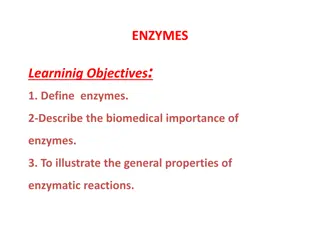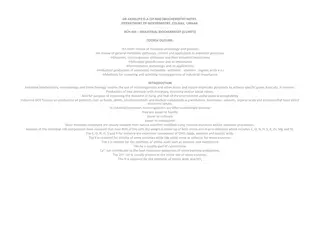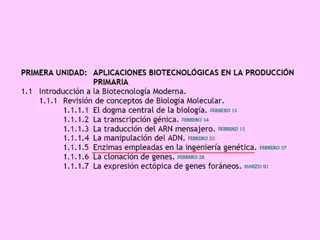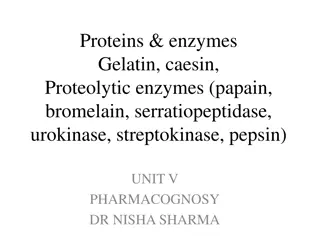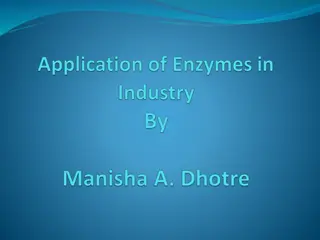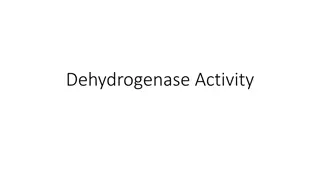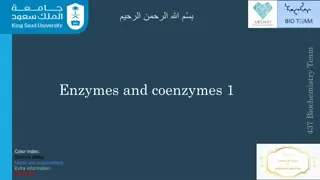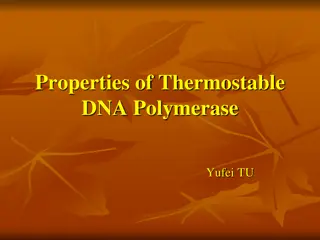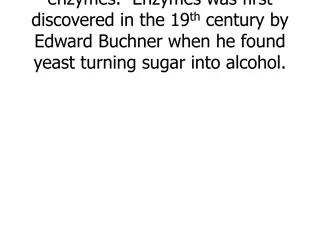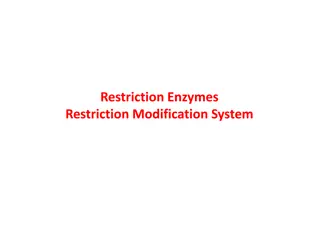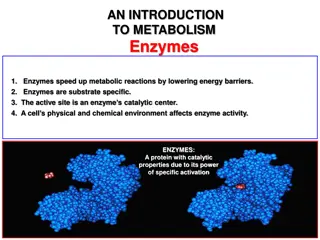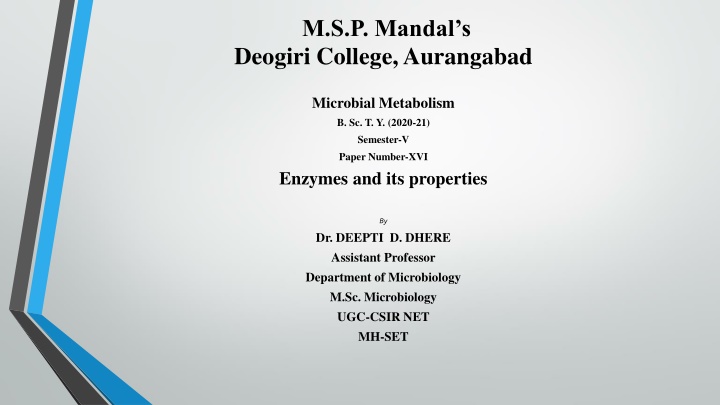
Enzymes: Key Concepts and Properties in Microbial Metabolism
Explore the role of enzymes in microbial metabolism, including the definitions, properties, and activation energy required for biological reactions. Dive into the interplay between catabolic and anabolic pathways, enzyme specificity, and the impact of temperature and pressure on reaction rates.
Download Presentation

Please find below an Image/Link to download the presentation.
The content on the website is provided AS IS for your information and personal use only. It may not be sold, licensed, or shared on other websites without obtaining consent from the author. If you encounter any issues during the download, it is possible that the publisher has removed the file from their server.
You are allowed to download the files provided on this website for personal or commercial use, subject to the condition that they are used lawfully. All files are the property of their respective owners.
The content on the website is provided AS IS for your information and personal use only. It may not be sold, licensed, or shared on other websites without obtaining consent from the author.
E N D
Presentation Transcript
M.S.P. Mandals Deogiri College, Aurangabad Microbial Metabolism B. Sc. T. Y. (2020-21) Semester-V Paper Number-XVI Enzymes and its properties By Dr. DEEPTI D. DHERE Assistant Professor Department of Microbiology M.Sc. Microbiology UGC-CSIR NET MH-SET
Points at a Glance Metabolism is sum of all chemical transformations in the cell Metabolism consist of catabolism and anabolism Catabolism includes all degradative reaction to produce energy (ATP) Anabolism includes all biosynthetic reactions which consume energy for the bond formation and requires raw ingredients All metabolic reactions are present in the series called as metabolic pathway Catabolic and anabolic pathways are interlinked and interdependent. In metabolic pathway redox reactions takes place Reactions in metabolic pathways are catalysed by reaction specific enzyme
Introduction Reactions in Metabolic pathways are catalysed by the enzymes The collision theory states that chemical reactions can occur when atoms, ions and molecules collide. Activation energy is required to disrupt the electronic configuration Reaction rate is the frequency of collision with enough energy to bring about reaction. Rate of reaction can be increased by enzymes by lowering the activation energy. Rate of reaction can also increased by increasing temperature and pressure up to certain extent.
About Enzymes The term enzymes was firstly coined by Wilhem Khune (1878) The enzyme means in Yeast Berzelius firstly defined the nature of the enzyme and proposed that ferment produced are catalyst in living cell. Anselme Payen discovered in 1833 the first enzyme who called Diastase J.B. Summer isolated and crystalized first enzyme i.e. Urease. Zymazes are enzymes which are already screened in its active form Zymogen are inactive form of enzyme secreted in cell which needs pre-treatment
Enzymes Definition- The enzymes are the biocatalyst which increases rate of biological reactions by decreasing activation energy and without being consumed and remain unaltered Some general properties of the enzymes 1. Unaltered state 2. Quantity 3. Protein Nature 4. Rate of Reaction 5. Reversibility 6. Denaturation 7. Activation 8. Enzyme specificity Activation energy- it is defined as the minimum amount of extra energy required by reacting molecule to get converted into product or The minimum amount of energy needed to activate or energize molecule or atoms so that they can undergo a chemical reaction.
Rate of reaction and its Dependence on the Activation Energy Activation energy is the least amount of energy needed for a chemical reaction to take place. Enzyme as a bio-catalyst acts on a substrate in such a way that they lower the activation energy threshold by changing the route of reaction Example- Cabonic anhydrase catalyse the hydration of the 106CO2 molecules per second which is 107faster than spontaneous reaction
IN prokaryotes site of enzyme synthesis is cytoplasm and it is synthesized by Ribosomes
Enzyme As a Biocatalyst Enzymes are called as BIO-catalyst and not the catalyst Enzyme shares some characteristics of the catalyst which are- 1. It increases the rate of reaction 2. It decreases activation energy 3. It remain unaltered after reaction There are some properties of enzymes which are different from catalyst Sr. No. Features Biocatalyst Catalyst Specificity 1. Highly specific for substrate and type of reactions Not specific for reaction Rate of Reaction Regulation 2. Increases by 103to106 fold. Increases by some fractions only 3. Regulated by time, temperature, pH, [S], [E], metal ions Not regulate Saturation 4. Maximum rate of reaction at substrate saturation concentration They do not show saturation Chemical Nature 5. Mainly protein in nature some exceptions are there where enzymes are RNA in nature They are metals, non metals and inorganic substances Temp., Pressure and pH Side reaction 6. Need a biocompatible system for optimum activity Need high temperature, pH and pressure 7. Not present. They are specific for their reactions. They show side reactions.
Characters of the Biocatalyst Binding of enzyme to substrate may not be specific but the reaction catalysed by it is always specific. It shows particular type of thermodynamics properties which describes its mechanism of action Stability depends on free energy, if free energy is less then more stable is the compound Free energy is shown by G, if G is negative, free energy of the substrate is more and hence reaction can occur in forward direction and spontaneously. The product formed after reaction has less free energy and hence it is more stable If G is positive the energy possessed by the product is high and hence reaction can go in reversed direction When G for a reaction is zero, a reaction is said to be at equilibrium. (Equilibrium does not mean equal concentration)
Properties of the Enzymes Enzyme has great catalytic power Enzyme are highly specific for their reaction Enzymes shows varying degree of specificities i.e. absolute specificity, stereo-specificity, Reaction specificity Group specificity etc. Activity of enzyme can be controlled but activity of catalyst can not be controlled All enzymes are protein except-Ribozymes which are RNA in nature Like proteins enzymes can be coagulated by alcohol, heat, concentrated acids and alkaline reagents Enzymes shows high rate of reaction at optimum temperature Enzyme has optimum pH where it s activity is at peak Inorganic substances known as activators can increases the rate of reaction Inhibitors are those compounds that decreases the activity of the enzymes or inactivates it.
Thank You Thank You


